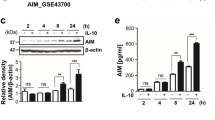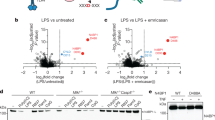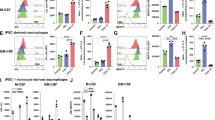Abstract
Fas ligand is a well-characterized apoptosis inducer. Here we demonstrate that Fas ligand induces the processing and secretion of interleukin-1β (IL-1β) in peritoneal exudate cells. This IL-1β secretion is independent of IL-1β converting enzyme (caspase 1), yet it is inhibited by caspase inhibitors, indicating that a caspase(s) in addition to IL-1β converting enzyme can process IL-1β. Inoculation of tumor cells expressing Fas ligand into wild-type mice induces a massive neutrophil infiltration that is, in contrast, suppressed in IL-1α/β knockout mice. These results demonstrate a newly discovered role for Fas ligand in inflammation, and challenge the dogma that apoptosis does not induce inflammation.
This is a preview of subscription content, access via your institution
Access options
Subscribe to this journal
Receive 12 print issues and online access
$209.00 per year
only $17.42 per issue
Buy this article
- Purchase on Springer Link
- Instant access to full article PDF
Prices may be subject to local taxes which are calculated during checkout





Similar content being viewed by others
References
Suda, T., Takahashi, T., Golstein, P. & Nagata, S. Molecular cloning and expression of the Fas ligand: a novel member of the tumor necrosis factor family. Cell 75, 1169 –1178 (1993).
Suda, T. et al. Expression of the Fas ligand in cells of T cell lineage. J. Immunol. 154, 3806–3813 (1995).
Rouvier, E., Luciani, M.-F. & Golstein, P. Fas involvement in Ca2+-independent T cell-mediated cytotoxicity. J. Exp. Med. 177, 195–200 (1993).
Arase, H., Arase, N. & Saito, T. Fas-mediated cytotoxicity by freshly isolated natural killer cells. J. Exp. Med. 181, 1235– 1238 (1995).
Suda, T. & Nagata, S. Why do defects in the Fas-Fas ligand system cause autoimmunity? J. Allergy Clin. Immunol. 100, S97–101 (1997).
Nagata, S. & Suda, T. Fas and Fas ligand: lpr and gld mutations. Immunol. Today 16, 39 –43 (1995).
Barker, C.F. & Billingham, R.E. Immunologically privileged sites. Adv. Immunol. 25, 1– 54 (1977).
Bellgrau, D. et al. A role for CD95 ligand in preventing graft rejection. Nature 377, 630–632 ( 1995).
Griffith, T.S., Brunner, T., Fletcher, S.M., Green, D.R. & Ferguson, T.A. Fas ligand-induced apoptosis as a mechanism of immune privilege. Science 270, 1189–1192 (1995).
Lau, H.T., Yu, M., Fontana, A. & Stoeckert, C.J. Prevention of islet allograft rejection with engineered myoblasts expressing FasL in mice. Science 273, 109– 112 (1996).
Kang, S.M. et al. Fas ligand expression in islets of Langerhans does not confer immune privilege and instead targets them for rapid destruction. Nature Med. 3, 738–743 ( 1997).
Allison, J., Georgiou, H.M., Strasser, A. & Vaux, D.L. Transgenic expression of CD95 ligand on islet beta cells induces a granulocytic infiltration but does not confer immune privilege upon islet allografts. Proc. Natl. Acad. Sci. U S A 94, 3943– 3947 (1997).
O'Connell, J., O'Sullivan, G.C., Collins, J.K. & Shanahan, F. The Fas counterattack: Fas-mediated T cell killing by colon cancer cells expressing Fas ligand. J. Exp. Med. 184, 1075– 1082 (1996).
Hahne, M. et al. Melanoma cell expression of Fas(Apo-1/CD95) ligand: implications for tumor immune escape. Science 274, 1363 –1366 (1996).
Niehans, G.A. et al. Human lung carcinomas express Fas ligand. Cancer Res. 57, 1007–1012 ( 1997).
Seino, K., Kayagaki, N., Okumura, K. & Yagita, H. Antitumor effect of locally produced CD95 ligand. Nat Med 3, 165–170 (1997).
Tanaka, M., Suda, T., Takahashi, T. & Nagata, S. Expression of the functional soluble form of human Fas ligand in activated lymphocytes. EMBO J. 14, 1129–1135 ( 1995).
Kayagaki, N. et al. Metalloproteinase-mediated release of human Fas ligand. J. Exp. Med. 182, 1777–1783 (1995).
Mariani, S.M., Matiba, B., Baumler, C. & Krammer, P.H. Regulation of cell surface APO-1/Fas (CD95) ligand expression by metalloproteases. Eur. J. Immunol. 25, 2303–2307 (1995).
Suda, T., Hashimoto, H., Tanaka, M., Ochi, T. & Nagata, S. Membrane Fas ligand kills human peripheral blood T lymphocytes, and soluble Fas ligand blocks the killing. J. Exp. Med. 186, 2045–2050 (1997).
Tanaka, M., Itai, T., Adachi, M. & Nagata, S. Downregulation of Fas ligand by shedding. Nature Med. 4, 31–36 (1998).
Sayers, T.J. et al. Effect of cytokines on polymorphonuclear neutrophil infiltration in the mouse. Prostaglandin- and leukotriene-independent induction of infiltration by IL-1 and tumor necrosis factor. J. Immunol. 141, 1670–1677 (1988).
Suda, T., Tanaka, M., Miwa, K. & Nagata, S. Apoptosis of mouse naive T cells induced by recombinant soluble Fas ligand and activation-induced resistance to Fas ligand. J. Immunol. 157, 3918–3924 (1996).
Iwai, K. et al. Differential expression of bcl-2 and susceptibility to anti-Fas-mediated cell death in peripheral blood lymphocytes, monocytes, and neutrophils. Blood 84, 1201–1208 ( 1994).
Liles, W.C., Kiener, P.A., Ledbetter, J.A., Aruffo, A. & Klebanoff, S.J. Differential expression of Fas (CD95) and Fas ligand on normal human phagocytes: implications for the regulation of apoptosis in neutrophils. J. Exp. Med. 184, 429–440 (1996).
Li, P. et al. Mice deficient in IL-1 β-converting enzyme are defective in production of mature IL-1 β and resistant to endotoxic shock. Cell 80, 401–411 ( 1995).
Kuida, K. et al. Altered cytokine export and apoptosis in mice deficient in interleukin- 1 β converting enzyme. Science 267 , 2000–2003 (1995).
Irmler, M. et al. Granzyme A is an interleukin 1 β-converting enzyme. J. Exp. Med. 181, 1917– 1922 (1995).
Mizutani, H., Schechter, N., Lazarus, G., Black, R.A. & Kupper, T.S. Rapid and specific conversion of precursor interleukin 1 β (IL-1 β) to an active IL-1 species by human mast cell chymase. J. Exp. Med. 174, 821–825 (1991).
Lindemann, A. et al. Granulocyte/macrophage colony-stimulating factor induces interleukin 1 production by human polymorphonuclear neutrophils. J. Immunol. 140, 837–839 (1988).
Parsey, M.V., Tuder, R.M. & Abraham, E. Neutrophils are major contributors to intraparenchymal lung IL-1 β expression after hemorrhage and endotoxemia. J. Immunol. 160, 1007–1013 (1998).
Hogquist, K.A., Nett, M.A., Unanue, E.R. & Chaplin, D.D. Interleukin 1 is processed and released during apoptosis. Proc. Natl. Acad. Sci. USA 88, 8485–8489 ( 1991).
Fantuzzi, G. et al. Effect of endotoxin in IL-1 beta-deficient mice. J. Immunol. 157, 291–296 (1996).
Colotta, F., Re, F., Polentarutti, N., Sozzani, S. & Mantovani, A. Modulation of granulocyte survival and programmed cell death by cytokines and bacterial products. Blood 80 , 2012–2020 (1992).
Ghayur, T. et al. Caspase-1 processes IFN-γ-inducing factor and regulates LPS-induced IFN-γ production. Nature 386, 619–623 (1997).
Kondo, T., Suda, T., Fukuyama, H., Adachi, M. & Nagata, S. Essential roles of the Fas ligand in the development of hepatitis. Nature Med. 3, 409– 413 (1997).
Nakamoto, Y., Guidotti, L.G., Pasquetto, V., Schreiber, R.D. & Chisari, F.V. Differential target cell sensitivity to CTL-activated death pathways in hepatitis B virus transgenic mice. J. Immunol. 158, 5692–5697 (1997).
Giordano, C. et al. Potential involvement of Fas and its ligand in the pathogenesis of Hashimoto's thyroiditis. Science 275, 960–963 (1997).
Jaffe, G.J. et al. Expression of interleukin-1 α, interleukin-1 β, and an interleukin-1 receptor antagonist in human retinal pigment epithelial cells. Exp. Eye Res. 55, 325– 335 (1992).
de Vos, A.F., Klaren, V.N. & Kijlstra, A. Expression of multiple cytokines and IL-1RA in the uvea and retina during endotoxin-induced uveitis in the rat. Invest. Ophthalmol. Vis. Sci. 35, 3873– 3883 (1994).
Horai, R. et al. Production of mice deficient in genes for interleukin (IL)-1α, IL- 1β, IL-1α/β, and IL-1 receptor antagonist shows that IL-1β is crucial in turpentine-induced fever development and glucocorticoid secretion. J. Exp. Med. 187, 1463– 1475 (1998).
Mizushima, S. & Nagata, S. pEF-BOS: a powerful mammalian expression vector. Nucleic Acids Res. 18, 5322 (1990).
Suda, T. & Nagata, S. Purification and characterization of the Fas ligand that induces apoptosis. J. Exp. Med. 179, 873–878 (1994).
Acknowledgements
We thank K. Suda and R. Hayashi for secretarial assistance. This work was supported in part by grants-in-aid from the Ministry of Education, Science and Culture of Japan, and by Special Coordination Funds of Science and Technology Agency of the Japanese Government.
Author information
Authors and Affiliations
Corresponding author
Rights and permissions
About this article
Cite this article
Miwa, K., Asano, M., Horai, R. et al. Caspase 1-independent IL-1β release and inflammation induced by the apoptosis inducer Fas ligand. Nat Med 4, 1287–1292 (1998). https://doi.org/10.1038/3276
Received:
Accepted:
Issue Date:
DOI: https://doi.org/10.1038/3276
This article is cited by
-
Blocking Fas signaling in adipose tissue ameliorates obesity-associated inflammation, insulin resistance, and hepatosteatosis
Journal of Pharmaceutical Investigation (2024)
-
Oligodendroglia-derived extracellular vesicles activate autophagy via LC3B/BAG3 to protect against oxidative stress with an enhanced effect for HSPB8 enriched vesicles
Cell Communication and Signaling (2022)
-
The NLRP3 inflammasome: molecular activation and regulation in spermatogenesis and male infertility; a systematic review
Basic and Clinical Andrology (2022)
-
Ptpn6 inhibits caspase-8- and Ripk3/Mlkl-dependent inflammation
Nature Immunology (2020)
-
RIP kinases as modulators of inflammation and immunity
Nature Immunology (2018)



